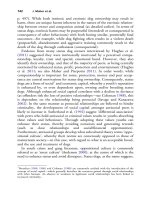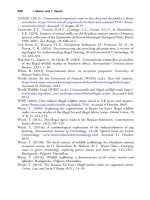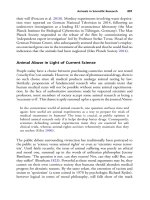The palgrave international handbook of a 129
Bạn đang xem bản rút gọn của tài liệu. Xem và tải ngay bản đầy đủ của tài liệu tại đây (26.63 KB, 1 trang )
Animal Hoarding
119
confidentiality (Clancy 2014; Patronek et al. 2006; Steketee et al. 2011).
Over 85 hoarding task forces have been established in communities large and
small, urban and rural in the USA, Canada, Australia and Europe (Bratiotis
and Woody 2014).
In New York City, there has been a concerted effort to provide a
coordinated response to hoarding cases. The American Society for the
Prevention of Cruelty to Animals (ASPCA) has instituted a Cruelty
Intervention Advocacy program that combines the talents of social workers, veterinary professionals, animal behaviorists, law enforcement agents,
and others to work with a wide array of human and animal service
agencies to respond to cases at the earliest possible stage and monitor
them on a regular basis. In addition to the ASPCA, agencies involved in
this collective effort have included the New York City Health
Department, Animal Control, Environmental Affairs, Agriculture
Department, Humane Law Enforcement, Mental Health Services,
Child Protection, Adult Protective Services, Housing Authority,
Department of Homeless Services, Human Resources Administration,
Community Affairs Bureau, and many other social service agencies.
Between 2010 and 2013 the ASPCA, working with these partners,
handled more than 100 hoarding cases. Of these, 67 % involved
women while 24 % involved male owners and 9 % were couples. Cats
comprised 76 % of the cases while 13 % involved dogs (Colangelo 2013).
This approach has proven to be an effective tool to respond to many
hoarding cases without invoking the criminal justice system. The program employs a holistic approach to working with animal hoarders,
engaging clients to build trust and voluntarily agree to services and/or
relinquishment as appropriate. It also furthers the recognition that animal hoarding is a human welfare, animal welfare and community problem—not just an animal control issue.
Legal Actions
The goals of legal intervention into animal hoarding cases are to remove
animals and dependent humans from harmful environments and provide
treatment, to take steps that will reduce the likelihood of a recurrence of the
problem, and to hold those responsible accountable for their actions and,
where possible, seek restitution.
A major advantage of prosecution is that the criminal justice system may
provide the leverage necessary to broker a wide variety of solutions, including









